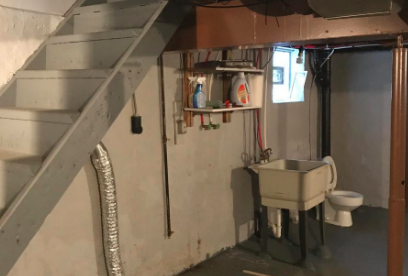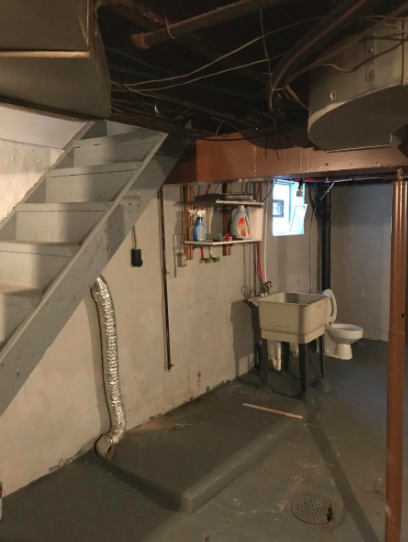The Pittsburgh Potty

Not too far from downtown Pittsburgh is a 3-bedroom, 1-bath house which really isn’t all that dissimilar from the other houses in the area. Click here for a slideshow from a real estate site — the photos are, most likely, from when the house was last on the market about a decade ago. It won’t take long for you to flip through the seven photos. There’s the front of the house, a wood backyard deck, the backyard itself, the kitchen, living room, bathroom — and then, the basement. It’s pretty standard.
Except… wait, what’s in the basement? Let’s take a closer look.

Do you see it now? There’s a toilet in that basement, and it’s sitting there out in the open, offering no privacy to anyone who would venture to use it. And what’s even stranger is that there’s really nothing unique about this house — I selected it because it came up quickly in a Google search, and if you do your own searching, you’ll find more of the same. Around the Pittsburgh area, there are lots of houses with similar plumbing situations; that is, it’s rather common to find a toilet in the basement which isn’t shielded from the rest of the room. Per one area real estate agent, via CBS’s local affiliate, “you’re going to find [a toilet like this] probably in 75 percent of the houses” in some neighborhoods. It even has a name: the Pittsburgh Potty.
Pittsburgh Potties have been around for about 80 years and no, people didn’t have weird habits back in the day. They just had different plumbing needs. Early municipal plumbing systems weren’t built to handle a toilet etc. in every house, and as populations grew and indoor plumbing became something we took for granted, the sewage systems in many areas couldn’t handle the throughput. The Pittsburgh Potties — which you’ll find in many places around the country beyond Pittsburgh — typically date back to before World War II when plumbing just wasn’t up to the standards of today. As Family Handyman explains, “thanks to old school plumbing technology, sewage backups were much more frequent many years ago.” And all of that stuff — whether it came from you or from the people around the corner — had to go somewhere. So it went backward, flowing into your house. (Gross.)
But there was a way to mitigate the damage a bit — the basement toilet. Per the Today Show, “If there was a sewage backup on your street, it would come into your home through the fixture that’s lowest to the ground.” Toilets worked better than sinks and other fixtures — as one architect told Pittsburgh’s local NPR affiliate, “the toilet is the largest fixture that’s connected to the system” and the one best suited to handle a large amount of goop. By hooking a toilet up in this room, you could keep the sewage out of your nice bathroom. The solution wasn’t perfect; the best result was a basement floor that really, really needs to be cleaned. But it was better than the alternative, and all it cost you was the price to install a toilet in your basement — you didn’t even have to put walls around it.
Today, the Pittsburgh Potty is almost entirely obsolete, but as removing the toilets isn’t free, almost all homeowners just let the toilet be.
Bonus fact: Outhouses, thankfully, are rare in the United States today. But that wasn’t always the case, and you’ll still see some (often as historical relics) scattered across the country. And some, like the one pictured here, have two stories. That’s… well, that’s particularly gross because the person using the bottom-level one is going to be in the line of fire of the person using the top-level one. Or, at least, that’s what you may have assumed. But in this case, there’s a very good reason for the double-decker dump box: snow. The image above is from an outhouse in Wyoming, and while the top level was usually locked (to prevent really terrible accidents) when the snow became too high to get into the lower level, the owner unlocked the top.
From the Archives: A Fly on the Urinal: How a sticker (and perhaps some male immaturity) helps keep airport bathrooms clean.
